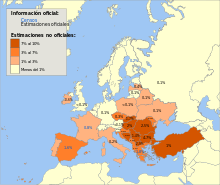Romani people in Austria
|
Chromolithograph entitled Enfants Tsiganes (Autriche) [Gipsy Children, Austria]; published by Garnier, Paris, printed by Testu & Massin, Paris. | |
| Total population | |
|---|---|
|
6,273 (2001 census) 10,000 to 25,000 Unofficial estimations | |
| Languages | |
| Romani, Sintitikes, German | |
| Religion | |
| Christianity |
The Romani are an ethnic group that has lived in Austria since the Middle Ages.[1] According to the 2001 census, there were 6,273 Romani in Austria or less than 0.1% of the population. Unofficial estimations count between 10,000 to 25,000.[2] Most indigenous Romani people in Austria belong to the Burgenland-Roma Group, in East-Austria. The Majority live in the State of Burgenland, in the City of Oberwart and in villages next to the District of Oberwart. The Burgenland-Roma speak the Vlax Romani language.
In Upper Austria there are also some Sinti families. 80% of the Sinti speak the Sinte Romani dialect of the Romani language.
Since 1960, there are also a significant Roma population which hails originally from former yugoslavian countries, especially from Serbia (Gurbeti and Kalderash Roma-Groups) and Ashkali from Kosovo.
History

In the Habsburg Monarchy under Maria Theresa (1740–1780), a series of decrees tried to force the Romanies to permanently settle, removed rights to horse and wagon ownership (1754), renamed them as "New Citizens" and forced Romani boys into military service if they had no trade (1761), forced them to register with the local authorities (1767), and prohibited marriage between Romanies (1773). Her successor Josef II prohibited the wearing of traditional Romani clothing and the use of the Romani language, punishable by flogging.[3]
See also
- Ethnic groups in Austria
References
- ↑ "Performance in Gypsy Autobiographies from Austria and Germany". Dickinson College. Retrieved 2012-08-26.
- ↑ "World Directory of Minorities and Indigenous Peoples - Austria : Roma/Gypsies". United Nations Human Rights Council. Retrieved 2012-08-26.
- ↑ Samer, Helmut (December 2001). "Maria Theresia and Joseph II: Policies of Assimilation in the Age of Enlightened Absolutism.". Rombase. Karl-Franzens-Universitaet Graz.
External links
- "Gypsy-politics" in Austria and Hungary
- Minority rights profile
- Letter Concerning Situation of Roma in Austria
| ||||||||||||||||||||
| ||||||||||
.jpg)